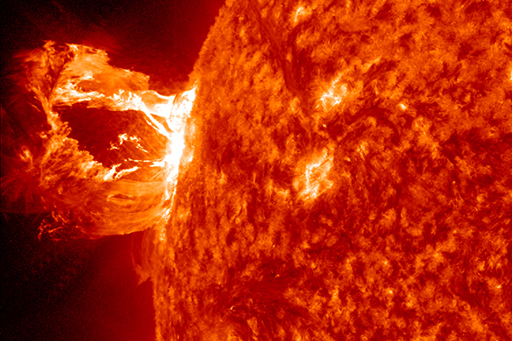2.2.2 Mass, luminosity and temperature
Stars need a power source, since they are constantly radiating away energy into space as light and heat – if they didn’t have one, they would gradually fade away and cool.
Luminosity
The Hertzsprung-Russell diagram implies that on the main sequence the more massive a star is, the more luminous it is as well. So massive stars must produce more energy than less massive stars. This sounds sensible – surely massive stars have more fuel to burn, which is why they produce more energy. This is true – but the mass of a star is not directly proportional to the amount of energy it emits.
Imagine a star with ten times the mass of the Sun. This would have ten times as much fuel to burn as the Sun, so would have the same brightness as the Sun but live for ten times longer if it burned its fuel at the same rate. However, such stars are approximately ten thousand times brighter than the Sun rather than being the same brightness. It turns out that the luminosity of a star is proportional to its mass (M) to the power four (that is M × M × M × M). In other words, a star that is twice as heavy as the Sun, is not twice as luminous – it would be 2 × 2 × 2 × 2 = 16 times as luminous.
Knowing this relationship between mass and luminosity helps to understand how long a star will live. A star that is twice as massive as the Sun is 16 times as luminous, so it must be burning its fuel 16 times more quickly. But because it is only twice the mass of the Sun, it only has twice as much fuel – so it will run out of fuel much more quickly than the Sun. It will only live for 2/16 (= 1/8) of the lifetime of the Sun. Therefore, more massive stars have much shorter lifetimes than smaller stars.
Temperature
The internal temperature of a star is also proportional to its mass, so a star twice as massive as the Sun is twice as hot at its core.
This might seem obvious, as it is related to what is shown on the Hertzsprung-Russell diagram – but remember that the Hertzsprung-Russell diagram plots the surface temperature of a star, and not its core. This is the key to understanding the relationship between stellar luminosity and mass on the main sequence.
The rate at which energy is released in a star – and hence its luminosity – appears to be directly related to its core temperature, which in turn depends on the star’s mass. But why does the energy release depend on core temperature? Considering at the reactions going on in the interior of stars can help explain.
In the next section, you’ll think about the nuclear reactions that are going on inside of stars.

